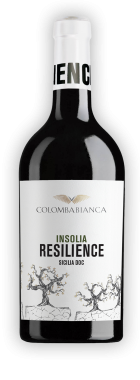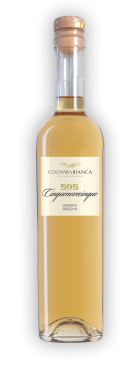VITECOLOGY, NEW MODELS IN THE VINEYARD
“We are trying to move toward a model of sustainable agriculture,” comments Mattia Filippi of Uvasapiens, Colomba Bianca’s consultant winemaker, “through the increase of biodiversity and organic matter in the soils: complex agricultural models that involve the cultivation of forests and wider ecological contexts. I have christened it ‘Vitecology’ and it is the union between the horizons of new viticulture and ecological trends, to counter phenomena arising from climatic misalignments: desertification, drought, chemical and physical instability of the soil.” Making an in-depth analysis of the climatic impact in the vineyard is Luca Mercalli president of the Italian Meteorological Society and scientific journalist-asked precisely by Colomba Bianca, the expert explains, “The Mediterranean climate of Sicily generates favorable conditions for viticulture, which, however, in recent decades are changing under the pressure of global warming. The long historical series of the Vaiana Observatory in Palermo shows in the period 1974-2022 an average temperature increase of 2.5 °C. In addition, Sicily’s proximity to the northern African coast makes the incursions of the scorching Saharan anticyclone more frequent, which on Aug. 11, 2021 recorded at the SIAS station in Floridia (Syracuse), 48.8 °C: a record heat value for Italy and Europe.”
CLIMATE RESILIENCE AND DROUGHT STRESS
What does this mean for our crops? “Grapes have good climate resilience,” Mercalli continues, “and are adapted to a wide range of thermopluviometric conditions, but still goes into stress if temperatures rise excessively and if there is a lack of rainfall for prolonged periods. Above 35 °C, vegetative activity is impaired, and in extreme cases the plant may suffer permanent damage, with scorch marks on the clusters and leaf apparatus and consequent increase in fungal attacks. The main features of the current climate crisis are summarized in the IPCC’s Sixth Synthesis Report (March 2023): the Mediterranean is defined as a climate “hotspot,” an area of the planet experiencing a faster rise in temperatures than the global average. In general, the average annual temperature over the Mediterranean region is expected to increase (2 to 5 °C by 2100, depending on decarbonization options) and with it heat waves, droughts, forest fires, floods, and sea level rise (40 cm to 1 m by the end of the century), with damage to coastal infrastructure. Winters will become milder, with a reduction in the frequency of cold spells, while summers will become longer and warmer, with unprecedented extreme values. Global warming could therefore bring Sicily in the coming decades to conditions gradually more similar to North African countries, where viticulture, while it exists (in Morocco, Algeria, Tunisia), has national average productions that are about 1 percent of Italy’s, reflecting the distancing of those climates from the vocated band of the central northern Mediterranean.
SICILY, 2031-2060 SCENARIO
“In the work of Konstantinos Varotsos (Environmental Research Institute of Athens) and collaborators (2020),” Mercalli continues, “climate scenarios 2031-2060 in Sicily, Crete and Cyprus are presented: clear increases in temperature but modest signals on precipitation emerge, with no appreciable change in total amounts, but with possible increase in extreme events. In the worst case scenario, with no emission control in Sicily, there would be +2.1 °C in summer and +1.6/1.7 °C in other seasons. This would be equivalent to transforming Catania’s current average summer temperature of 24.5 °C as the respective temperature of Tunis (26.5 °C). The fact that average annual rainfall does not appear to change significantly, notwithstanding the fact that Sicily already has (at the lower-middle elevations) four to eight months of soil aridity, does not mean that water stress is not increasing: in fact, higher temperatures would cause an increase in evapotranspiration, which in the paper “Future trends of reference evapotranspiration in Sicily based on CORDEX data and Machine Learning algorithms” (F. Di Nunno and F. Granata, University of Cassino, 2023) are quantified towards the end of the century around +15-17%. The average temperature increase will also be followed by an increase in temperature extremes, which could frequently exceed 45 °C with peaks around 50 °C, definitely unfavorable for vines. Thermal sums and day-night excursions would also change, affecting aroma and pigment formation and the sugar and acidity levels of the berries. With these scenarios, it is clear that the vine’s vocated areas could change: from very sun-exposed slopes to shadier slopes and higher altitudes, in order to compensate for the increase in temperature and make greater use of soil moisture. According to a recent study by the Agricultural University of Athens,” Mercalli continues, “the impacts of climate change on viticulture will cause advances in the phenological calendar of the vine, alterations in the chemical composition of grapes and wine, greater crop variability, crop expansion into previously unsuitable geographic areas, and significant shifts in traditional grape-growing areas. The study concludes that “under the most pessimistic scenarios, northern European regions may become suitable for grape growing,” at the expense of southern European regions, which are too hot for grape production.”
COUNTERMEASURES TO BE TAKEN FROM A PREVENTIVE PERSPECTIVE
“In the short term,” Mercalli continues, “especially on soils that do not have sufficient water reserve from winter rainfall, it is advisable to plan for high-efficiency irrigation infrastructure (reservoirs, drip systems, local and satellite monitoring of water requirements), while also addressing the issue of evolving production regulations where irrigation is not allowed today. The genetic selection approach is crucial to recovering resilience, with research into cultivars that are more resistant to drought and summer heat, keeping in mind that this will require changes in traditional wine appellations. In mountainous and hilly areas, the choice of higher altitudes and less sunny exposures may allow the prerogatives of areas traditionally associated with vineyards to be maintained. The rapidity of the changes taking place will tend to put pressure on areas with their agro-technological supply chains and will require flexibility and foresight in dealing with new conditions. Viticulture, which is based on multi decade plantings, will not be able to react as quickly as the annual herbaceous crop sector and therefore needs a greater planning effort also associated with greater risk. Preparing in good time and following the very dynamic evolution of the climate is therefore crucial in order not to be caught by surprise.”
MORE EFFICIENT IRRIGATION INFRASTRUCTURE
A worrying scenario, which must be constantly monitored: “Colomba Bianca – concludes Colomba Bianca president Dino Taschetta – has undertaken this study path, with the aim of offering a support tool to apply the most appropriate agronomic techniques aimed at the productive stability of our vineyards and create qualified paths to raise the quality level of the Island’s wines. We want to be the spokesman for the entire sector in reference to the critical
issues to be addressed: the authoritative voice of Luca Mercalli leaves no room for maneuver with respect to the phenomenon of climate change, which must be addressed with the right awareness, starting precisely from irrigation infrastructure to a more far-sighted policy for the agricultural sector.”
For further insights, bibliographical references and data, the full study by Luca Mercalli is available at www.colombabianca.com






































